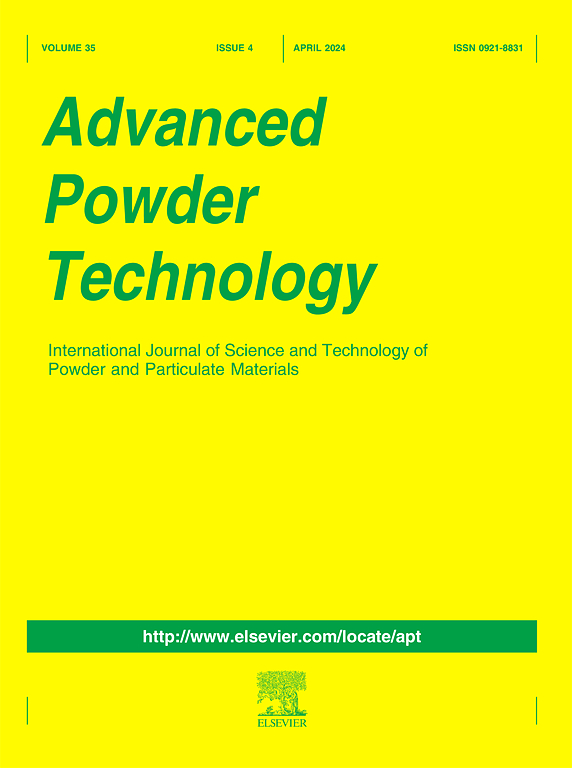Effect of yield stress on two-phase flow characteristics of gangue cemented backfill slurry in straight horizontal pipeline
IF 4.2
2区 工程技术
Q2 ENGINEERING, CHEMICAL
引用次数: 0
Abstract
The pipeline transportation is widely employed in mine backfill for delivering high concentration slurry. Based on the Euler-Euler two-fluid model, gangue cemented backfill slurry was abstracted as a dual-component structure consisting of fine gangue slurry (carrier fluid) and coarse gangue aggregates (transported particles). The influence of yield stress on the distribution of coarse aggregates, flow velocity, granular pressure, and pressure drop in GCB slurry is simulated. The results indicated that: 1) The coarse aggregates distribution was divided into coarse aggregate volume increasing zone (CG-VIZ), stable flow zone (SFZ), and coarse aggregate volume increasing zone (CG-VIZ). Increasing the yield stress can significantly reduce the coarse aggregate content and the extent of CG-VIZ resulting from segregation. 2) As the yield stress increases, the flow velocity transitions from an asymmetric ‘arch’ distribution to an asymmetric ‘plunger’ distribution in the vertical direction, while the asymmetry gradually diminishes. 3) The granular pressure distribution demonstrated a ‘U’ shape, with the maximum granular pressure occurring at the bottom of the pipeline. 4) The pressure loss of pipelines increases linearly with the increase of yield stress.

屈服应力对直水平管道中矸石胶结充填体两相流动特性的影响
管道输送在矿山充填中广泛应用于输送高浓度矿浆。基于Euler-Euler双流体模型,将矸石胶结充填料浆抽象为由细粒矸石浆(载体流体)和粗粒矸石骨料(输运颗粒)组成的双组份结构。模拟了屈服应力对GCB浆体中粗集料分布、流速、颗粒压力和压降的影响。结果表明:1)粗集料分布分为粗集料体积增大区(CG-VIZ)、稳流区(SFZ)和粗集料体积增大区(CG-VIZ)。增大屈服应力可显著降低粗骨料含量,降低因偏析而产生的CG-VIZ的程度。2)随着屈服应力的增大,在垂直方向上,流速由不对称的“拱型”分布转变为不对称的“柱塞型”分布,而不对称逐渐减弱。3)颗粒压力呈“U”型分布,最大颗粒压力出现在管道底部。4)管道压力损失随屈服应力的增大呈线性增加。
本文章由计算机程序翻译,如有差异,请以英文原文为准。
求助全文
约1分钟内获得全文
求助全文
来源期刊

Advanced Powder Technology
工程技术-工程:化工
CiteScore
9.50
自引率
7.70%
发文量
424
审稿时长
55 days
期刊介绍:
The aim of Advanced Powder Technology is to meet the demand for an international journal that integrates all aspects of science and technology research on powder and particulate materials. The journal fulfills this purpose by publishing original research papers, rapid communications, reviews, and translated articles by prominent researchers worldwide.
The editorial work of Advanced Powder Technology, which was founded as the International Journal of the Society of Powder Technology, Japan, is now shared by distinguished board members, who operate in a unique framework designed to respond to the increasing global demand for articles on not only powder and particles, but also on various materials produced from them.
Advanced Powder Technology covers various areas, but a discussion of powder and particles is required in articles. Topics include: Production of powder and particulate materials in gases and liquids(nanoparticles, fine ceramics, pharmaceuticals, novel functional materials, etc.); Aerosol and colloidal processing; Powder and particle characterization; Dynamics and phenomena; Calculation and simulation (CFD, DEM, Monte Carlo method, population balance, etc.); Measurement and control of powder processes; Particle modification; Comminution; Powder handling and operations (storage, transport, granulation, separation, fluidization, etc.)
 求助内容:
求助内容: 应助结果提醒方式:
应助结果提醒方式:


